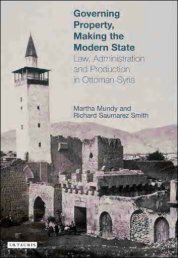The Young Turk Period, 1908-1918 - PSI424
The Young Turk Period, 1908-1918 - PSI424
The Young Turk Period, 1908-1918 - PSI424
Create successful ePaper yourself
Turn your PDF publications into a flip-book with our unique Google optimized e-Paper software.
316 <strong>The</strong> Rise of Modern <strong>Turk</strong>ey, 1808-1975<br />
was 2.5 million. According to the Ottoman census in 1914, however, it was at the most<br />
1.3 million. Half of these people resided in the areas affected by the deportations, but<br />
with the city dwellers allowed to remain, it appears that about 400,000 people actually<br />
were transported in 1915-16. In addition, some 700,000 Armenians fled to the Caucasus,<br />
western Europe, and the United States. As 100,000 remained in <strong>Turk</strong>ey after<br />
the war, one can conclude that about 300,000 died if one accepts the Ottoman census<br />
reports, or 1.3 million if the Armenian figures are utilized. 160<br />
<strong>The</strong> Armenians also feel that the deaths resulted from a planned policy of genocide<br />
by the Ottoman government. This accusation was repeated by several European commissions<br />
during and after the war. <strong>The</strong> Ottoman cabinet records, however, do not confirm<br />
this, but, rather, manifest numerous efforts to investigate and correct a situation<br />
in which some 6 million people - <strong>Turk</strong>s, Greeks, Arabs, Armenians, Jews, and others -<br />
were being killed by a combination of revolts, bandit attacks, massacres and counter<br />
massacres, and famine and disease, compounded by destructive and brutal foreign invasions<br />
in which all the people of the empire, Muslim and non-Muslim alike, had their<br />
victims and criminals. 161 Considerable further study is needed to determine the exact<br />
degree of blame and responsibility that can be assigned to each of the parties involved.<br />
In April 1915, even before the deportation orders were issued, Dashnaks from<br />
Russian Armenia organized a revolt in the city of Van, whose 33,789 Armenians<br />
comprised 42.3 percent of the population, closest to an Armenian majority of any<br />
city in the empire. While the local Armenian leaders tried to restrain their followers,<br />
knowing they would suffer in any prolonged communal conflict with the<br />
Muslim majority, they were overwhelmed by the agitators from the north, who<br />
promised Russian military assistance if only they showed their loyalty to the czar<br />
by helping to drive the Muslims out. <strong>The</strong> Russian army of the Caucasus also began<br />
an offensive toward Van with the help of a large force of Armenian volunteers<br />
recruited from among refugees from Anatolia as well as local Caucasian<br />
residents. Leaving Erivan on April 28, 1915, only a day after the deportation orders<br />
had been issued in Istanbul and long before news of them could have reached<br />
the east, they reached Van on May 14 and organized and carried out a general<br />
slaughter of the local Muslim population during the next two days while the small<br />
Ottoman garrison had to retreat to the southern side of the lake. An Armenian<br />
state was organized at Van under Russian protection, and it appeared that with<br />
the Muslim natives dead or driven away, it might be able to maintain itself at one<br />
of the oldest centers of ancient Armenian civilization. An Armenian legion was<br />
organized "to expell the <strong>Turk</strong>s from the entire southern shore of the lake in<br />
preparation for a concerted Russian drive into the Bitlis vilayet." 162 Thousands<br />
of Armenians from Mu§ and other major centers in the east began to flood into<br />
the new Armenian state, including many who broke away from the deportation<br />
columns as they passed the vicinity on their way to Mosul. By mid-July there were<br />
as many as 250,000 Armenians crowded into the Van area, which before the crisis<br />
had housed and fed no more than 50,000 people, Muslim and non-Muslim alike. 163<br />
Early in July, however, Ottoman reinforcements pushed the Russo-Armenian army<br />
back. It was accompanied by thousands of Armenians who feared punishment for<br />
the killings that had made possible the short-lived state. "<strong>The</strong> panic was indescribable.<br />
After the month-long resistance to Cevdet Bey, after the city's liberation,<br />
after the establishment of an Armenian governorship, all was blighted. Fleeing behind<br />
the retreating Russian forces, nearly two hundred thousand refugees, losing<br />
most of their possessions in repeated Kurdish ambushes, swarmed into Transcaucasia,"<br />
164 with as many as 40,000 Armenians perishing during the flight. <strong>The</strong>












